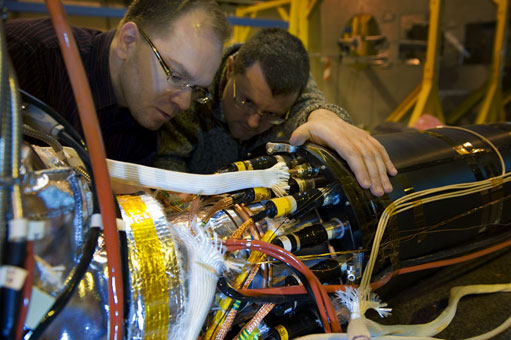
ATLAS e-News
23 February 2011
LUCID's electronics relocate
10 November 2008

Richard Soluk and Benedetto Giacobbe during the mounting of LUCID around the beam pipe, in Prevessin last spring. (Courtesy of Claudia Marcelloni)
Shortly after first beam, we reported LUCID’s successful recording of the splash events. “Everything was running fine,” says Marco Bruschi. “LUCID was quite successful.”
Now that the cavern is opened up and everyone is considering what improvements their detectors need, the LUCID crew has decided to make their electronics more accessible.
As reported during the June commissioning, accessing LUCID is a challenge because it’s sitting on the shielding blocks surrounding the beam pipe, at about 15 metres above the cavern floor. Shortly after the LHC unexpectedly shut down, a part of LUCID’s front end electronics broke, rendering the Side A half of LUCID unable to take data.
“A short in one channel shut down the whole electronics for the detector on one side. This was a nasty surprise,” Marco explains. “This time it was relatively easy to gain access and change the faulty card, but in the future, the octagonal pieces of the forward shielding will be installed and we will not have access to this area. This problem was therefore a wake-up call, and we therefore considered the option to move our electronics to a more accessible position.”
The increased distance between LUCID and the front end electronics will also slightly decrease the signal amplitude, but, with the gained experience, it seems now “a reasonable price to pay” for the increased accessibility, according to Marco.
Rather than sitting atop the shielding with the detector itself, the electronics have been relocated to Level 5 of the blue permanent scaffolding that lines the walls of the cavern. The move happened a little over a month ago, taking only a day.
Just under two weeks ago, on Tuesday, October 28th, they reconnected all the cables. Now, it will be possible to repair the electronics during short access periods while the detector is running. They are currently testing out the detector in its new situation, paying close attention to the difference in signal to noise ratio.
Work on the detector itself is at a standstill because it is covered by the Big Wheels and the End Cap Toroids. However, Marco’s team have requested the chance to make a few repairs toward the end of the shut-down period. He says: “We realised that two channels of LUCID are not responding and so we would like to fix them.”
Another possible intervention concerns a few broken calibration fibres. These fibres are used to send light into the detector, mimicking an event. This way, they can find the correlation between the amount of light sent into the detector and the strength of the electrical signal read out. The team is studying a method to repair these as well once the opportunity arises.

Katie McAlpineATLAS e-News |